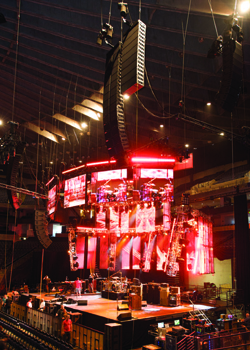
“We’re working with a very organic set of sounds here,” says Robert Scovill, ruminating on the current Tom Petty & The Heartbreakers 2010 concert tour.
“Piano, organ, old amps… a traditional drum kit. We don’t want to make things sound real modern.”
“What we want is a transparent presentation of the way things are. That’s where digital comes in.”
“Using modern technology to reveal traditional and established sounds – I think that’s a great way to go.”
Scovill knows well of what he speaks, and of the technical evolution that has helped bring him to where he is today with the band.
Having pushed faders out front for Tom and the boys since right about the same time e-mail was sounding like a pretty darn good idea, for this tour the Front of House engineer gains the backing of a D-Show VENUE console from Avid and an L-Acoustics K1/KUDO rig supplied by Escondido, California-based Sound Image.
“I don’t want to ever lead people to believe we’re attempting to simply recreate the record live,” Scovill explains, commenting on the audio underpinnings that guide this series of dates running through October supporting Mojo, the band’s first studio offering in eight years.
“That will never be the spirit of what Tom Petty & The Heartbreakers are about at their live performances. They have been together a very long time and have gotten to know each others’ moves implicitly not just onstage, but musically too.”
“You never get into a routine with them where Tuesday night is the same as Thursday and that’s the same as Saturday.”
“Even with the big production elements surrounding this show, there is still a looseness to it,” he continues.
“Any given song can take a left turn at any moment and go in a completely different direction. This is definitely an ensemble with a collective will, not a group of musicians spoon-fed with material by a frontman.”
A DSP advantage was gained, however, in being able to port effects settings built by engineer Ryan Ulyate during the mixing of Mojo directly into the plug-in processing of the VENUE system.
That process was facilitated by the fact that Mojo was mixed entirely “in the box” using a single ICON and Pro Tools system, with plug-ins brought over directly from the recording sessions including Sound Toys, Acousticas EMT impulses and Digidesign Delays.
Many of the vocal treatments for Petty himself – especially on newer songs – were pulled directly from the record for the live stage based upon their ability to manage what Scovill refers to as “extreme aspects” such as exceptionally narrow, cone-shaped vocals and slap delays he wound up using to underscore the “vintage-y” vibe.
Scovill is quick to add that he doesn’t routinely lean on plug-in compression unless the situation warrants it, opting in many cases for the channel strip processing already onboard the console.
For the times he does step out from his own internal circuitry for applications like system EQ or group processing, he gains the benefit of a Serato Rane Series of dynamic EQ plug-ins or their parametric offering.

